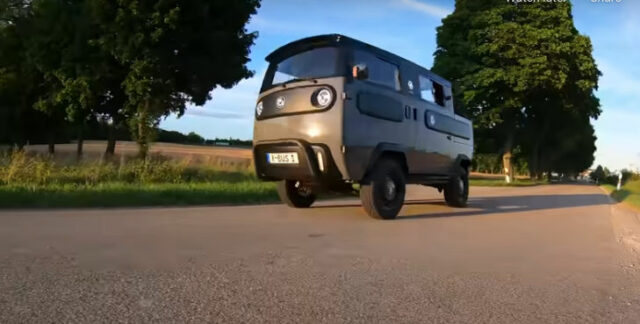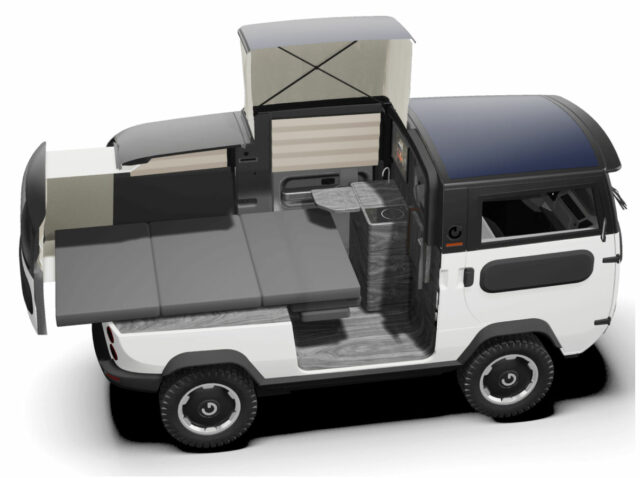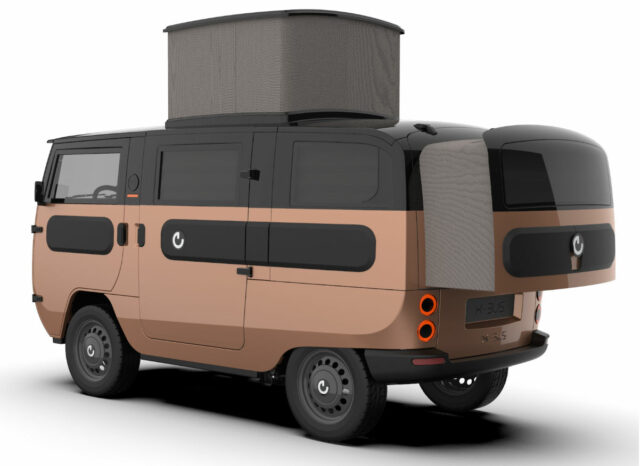
The country of autobahns and popular car models, Germany is among the leading regions in electric vehicle development. Enterprises are not only cranking out electric versions of Volkswagen Golfs or Audi A3s, but innovative businesses are trying out something new as well. Electric Brands is one of these innovators that recently introduced a prototype of its product. The startup has created an electric van called X-Bus that makes use of modules in its configuration.
It is not a coincidence that a modern family sedan, van, pickup truck, coupé, or station wagon are what they are today. They have tens of years of evolution behind. Electric vehicles can – and to a certain extent will – change the setup created by traditional petrol engine cars. The space within the chassis of an electric vehicle can be rethought. Many features are possible in electric cars that haven’t been possible earlier.
X-Bus is planned to be available in nine configurations. One of these is camper van. The key features are a sleeping area for two people, a compact kitchen with a sink, a refrigerator and hotplate. That’s very good for the small space available, only one vital feature is missing: a portable toilet, but perhaps there is space under the bench.
Lack of storage space makes the X-Bus suitable for weekend trips and other short getaways. For instance, a two week tour of Scandinavia requires clothes and shoes for all kind of weather.
View the video where the CEO of the company gives a sneak preview to the X-Bus:
The planned list price in Germany is attractive: about 18 000 euros. Larger battery and additional features increase the price. The production should start in 2022. Electric Brands is inviting people join their crowdfunding campaign.
When used as a campervan, the range of the vehicle is a crucial feature. The vendor claims 600 km / 373 mile range for the X-Bus with a large battery and solar panels. The maximum speed is 100 km/h. The van is compact and light so it can go a long way.

For a van, the X-Bus is very compact in size. It is just about 4 meters / 13 feet long, 2m / 6.5 feet tall, and 1m 70cm / 5.5 feet wide. Compared to the Nissan E-Nv200 (4m 56cm, 1m 85cm, 1m 75cm), the X-Bus is shorter. Below the details from Electric Brands:
| Technical data | XBUS Standard | XBUS Offroad |
| Length | 3945 mm | 3945 mm |
| Width | 1633 mm | 1691 mm |
| Height | 1963 mm | 2038 mm |
| Wheelbase | 2200 mm | 2200 mm |
| Front track width | 1352 mm | 1418 mm |
| Rear track width | 1287 mm | 1353 mm |
| Overhang in front | 964 mm | 964 mm |
| Rear overhang | 781 mm | 781 mm |
| Tires | 185/75 R16 | 185/75 R16 |
| Approach angle at the front | 26 degrees | 31 degrees |
| Departure angle at the rear | 41 degrees | 41 degrees |
| Ramp angle | 31 degrees | 40 degrees |
| Ground clearance in the middle | 239 mm | 244 mm |
| Outside ground clearance | 200 mm | 205 mm |
| Loading height | 955mm | 1030 mm |
| Drive | All-wheel drive | All-wheel drive |
| Motors | 4 wheel hub motors at 3.75KW continuous power | 4 wheel hub motors at 3.75KW continuous power |
| Duration of system performance | 15 KW | 15 KW |
| Peak performance | 56 KW | 56 KW |
| Suspension | Independent wheel suspension, front with double wishbones, rear with trailing arm axle | Independent wheel suspension, front with double wishbones, rear with trailing arm axle |
| Construction | Modular with interchangeable attachments | Modular with interchangeable attachments |
| Battery placement | In drawers, in the middle or at the back, depending on the module | In drawers, in the middle or at the back, depending on the module |
| Battery capacity | From 10 Kwh to 30 Kwh possible | From 10 Kwh to 30 Kwh possible |
| Range in Cityt mode at 10kwh on board | up to 200 km | up to 200 km |
| Range in mix mode at 10kwh on board | up to 140 km | up to 140 km |
| Range per extra battery pack city mode | up to 25 km | up to 25 km |
| Range per extra battery pack mix mode | up to 17.5 km | up to 17.5 km |
| Charging capacity of the solar roof in the driver’s cab approx 1.3m2 x 200W | 260 Watt Peak | 260 Watt Peak |
| Charging power solar roof center cabin approx 1.8m2 x 200W | 360 Watt Peak | 360 Watt Peak |
| Charging power solar roof rear module approx. 1m2 x 200W | 200 Watt Peak | 200 Watt Peak |
| Maximum torque | 1.200 NM | 1.200 NM |
| Battery system | Lithium battery packs at 1.25 kWh | Lithium battery packs at 1.25 kWh |
| Charging time AC up to 3.6 kw 1-phase socket at 10 kwh (10-80%) | approx. 3H | approx. 3H |
| Charging time AV 11 KW type 2 (10-80%) standard execution | less than 1H | less than 1H |
| Acceleration from 0 – 50 | cannot be displayed yet | cannot be displayed yet |
| Acceleration from 0-100 | cannot be displayed yet | cannot be displayed yet |
| Top speed | >100 km/h | >100 km/h |
| Braking distance | cannot be displayed yet | cannot be displayed yet |
| Empty weight depending on the chosen structure | approx. 500 – 800 kg without batteries | approx. 500 – 800 kg without batteries |
| Payload | approx. 800 – 1,100 kg | approx. 800 – 1,100 kg |
| Permissible total weight in kg | 1,600 kg | 1,600 kg |

Via The Driven.
